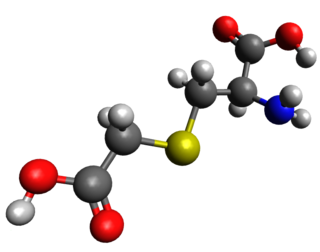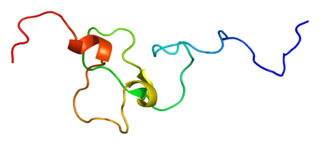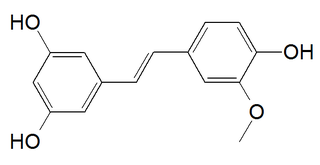
The renal outer medullary potassium channel (ROMK) is an ATP-dependent potassium channel (Kir1.1) that transports potassium out of cells. It plays an important role in potassium recycling in the thick ascending limb (TAL) and potassium secretion in the cortical collecting duct (CCD) of the nephron. In humans, ROMK is encoded by the KCNJ1 gene. Multiple transcript variants encoding different isoforms have been found for this gene.

Neon (10Ne) possesses three stable isotopes, 20Ne, 21Ne, and 22Ne. In addition, 17 radioactive isotopes have been discovered ranging from 15Ne to 34Ne, all short-lived. The longest-lived is 24Ne with a half-life of 3.38 minutes. All others are under a minute, most under a second. The least stable is 15Ne with a half-life of 7.7×10−22 s. See isotopes of carbon for notes about the measurement.
Roeslerstammiidae is a family of insects in the order Lepidoptera.

Carbocisteine, also called carbocysteine, is a mucolytic that reduces the viscosity of sputum and so can be used to help relieve the symptoms of chronic obstructive pulmonary disorder (COPD) and bronchiectasis by allowing the sufferer to bring up sputum more easily. Carbocisteine should not be used with antitussives or medicines that dry up bronchial secretions.
Camptoloma is a genus of moths in the family Noctuidae sensu lato. It was formerly incorrectly placed in Arctiidae.

Inhibitor of growth protein 4 is a protein that in humans is encoded by the ING4 gene.
Tineovertex is a genus of moths belonging to the family Tineidae.
Gerontha is a genus of moths belonging to the family Tineidae.

Triaxomera is a genus of the fungus moth family, Tineidae. Therein, it belongs to the subfamily Nemapogoninae.
Crypsithyris is a genus of moths belonging to the family Tineidae.

In molecular biology mir-210 microRNA is a short RNA molecule. MicroRNAs function to regulate the expression levels of other genes by several mechanisms.

Zinc finger protein 300 is a protein that in humans is encoded by the ZNF300 gene. The protein encoded by this gene is a C2H2-type zinc finger DNA binding protein and a likely transcription factor.

Isorhapontigenin is a tetrahydroxylated stilbenoid with a methoxy group. It is an isomer of rhapontigenin and an analog of resveratrol. It is found in the Chinese herb Gnetum cleistostachyum, in Gnetum parvifolium and in the seeds of the palm Aiphanes aculeata.
Basic leucine zipper transcription factor, ATF-like 2 is a protein that, in humans, is encoded by the BATF2 gene.
Rebecca Spindler is the Head of Science and Conservation at non profit conservation organisation Bush Heritage Australia. She previously was the Manager of Research and Conservation at Taronga Conservation Society Australia, in the New South Wales Office of Environment and Heritage (OEH).
Triaxomera puncticulata is a moth of the family Tineidae. It found in Japan.
Dinica is a genus of moths belonging to the family Tineidae.
Dr. Jason Huang, M.D., FAANS, FACS is a Chinese-born American neurosurgeon at Baylor Scott & White Health in Temple, TX. He is known for both clinical and research work in nervous system injury and repair, including traumatic brain injury, spinal trauma, and peripheral nerve injuries. He is the recipient of "U.S. News Top Docs".

Autochthonus is a genus of moths belonging to the family Tineidae. The genus was described in 1891 by Lord Walsingham.

Toripristone (INN) is a synthetic, steroidal antiglucocorticoid as well as antiprogestogen which was never marketed. It is reported as a potent and highly selective antagonist of the glucocorticoid receptor (GR), though it also acts as an antagonist of the progesterone receptor (PR). The pharmacological profile of toripristone is said to be very similar to that of mifepristone, except that toripristone does not bind to orosomucoid. The drug has been used to study the hypothalamic-pituitary-adrenal axis and has been used as a radiotracer for the GR. Its INN was given in 1990.










